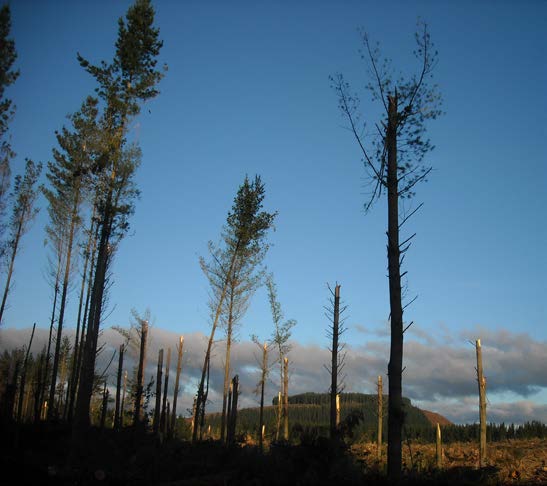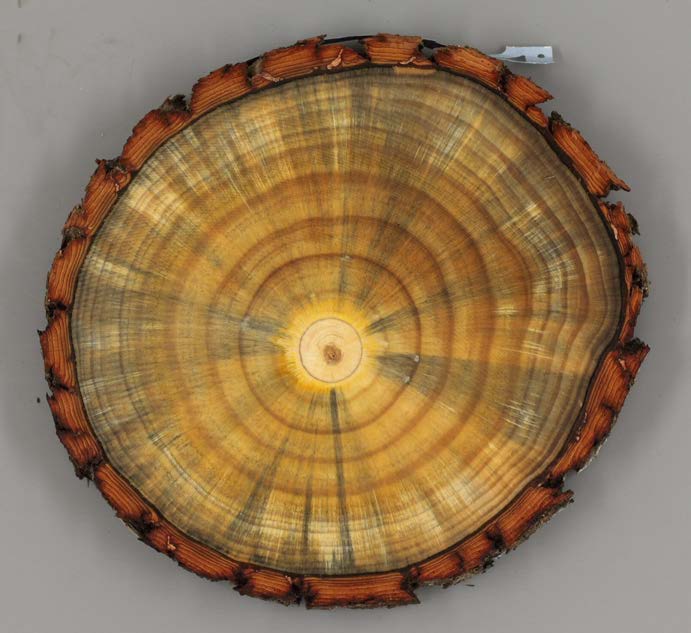PESTS AND DISEASES OF FORESTRY IN NEW ZEALAND
Storm damage and sapstain, estimating the salvage period in pine plantations
Scion is the leading provider of forest-related knowledge in New Zealand
Formerly known as the Forest Research Institute, Scion has been a leader in research relating to forest health for over 50 years. The Rotorua-based Crown Research Institute continues to provide science that will protect all forests from damage caused by insect pests, pathogens and weeds. The information presented below arises from these research activities.
From Forest Health News 223, March 2012.
The recent windy weather and the associated uprooting and stem breakage in some plantations have once again drawn attention to the cost of storms to the radiata pine industry.
In New Zealand’s blustery climate small scale events occur frequently while more damaging storms are a recurring if longer term hazard in pine forests throughout much of the country. Apart from the direct losses caused by the snapping of stems into pieces too short and, in younger stands, too small to salvage economically, there is an indirect cost as the wood in uprooted trees deteriorates before the valuable timber can be recovered.
 As the fallen stems dry, the wood cells become aerated allowing certain fungi with dark coloured hyphae, in particular, Sphaeropsis sapinea (synonym, Diplodia pinea) to grow through them and discolour the sapwood an unsightly blue. Basidiomycete fungi such as Phlebiopsis gigantea and Stereum sanguinolentum soon also invade the stems leading to brown staining of the wood and eventually to decay and loss of strength. The drying stems also attract wood- and bark-boring insects. The most common ones are Arhopalus ferus; Hylastes ater; Hylurgus ligniperda; Pachycotes peregrinus and Platypus apicalis. They can, particularly H. ater and H. liniperda, transmit other sapstain fungi with dark coloured hyphae and sticky spores (e.g. species of Ophiostoma). In this way the economic value of the fallen timber is soon diminished.
As the fallen stems dry, the wood cells become aerated allowing certain fungi with dark coloured hyphae, in particular, Sphaeropsis sapinea (synonym, Diplodia pinea) to grow through them and discolour the sapwood an unsightly blue. Basidiomycete fungi such as Phlebiopsis gigantea and Stereum sanguinolentum soon also invade the stems leading to brown staining of the wood and eventually to decay and loss of strength. The drying stems also attract wood- and bark-boring insects. The most common ones are Arhopalus ferus; Hylastes ater; Hylurgus ligniperda; Pachycotes peregrinus and Platypus apicalis. They can, particularly H. ater and H. liniperda, transmit other sapstain fungi with dark coloured hyphae and sticky spores (e.g. species of Ophiostoma). In this way the economic value of the fallen timber is soon diminished.
When pine plantations are extensively damaged by turbulent storms, immediate decisions are needed on where recovery operations should be concentrated in order to minimise the effect of these secondary losses. Although it is reasonable to concentrate on stands where there has been greater investment (e.g. mature pruned stands) it is also necessary to consider the merits of dealing with others before the damaged stems become unsalvageable.
Unfortunately there is a dearth of information on how long it takes for the wood in such stems to deteriorate to a point where they are not worth recovering. This became glaringly apparent following two storms during late winter 2008 that caused extensive damage to a forest in Nelson.
The concern raised led to the initiation of a research programme that ran for nearly four years in order to find answers to some of the questions. This project was collaborative, driven by the Forest Protection group at Scion, with much of the work being undertaken as part of an MSc student project with the University of Canterbury. It involved many people as well as the willing cooperation of a number of forest owners.

During this project discs were periodically sampled at intervals along the stems of selected fallen trees in order to evaluate the degree of sapstain, extent of drying and level of colonisation by sapstain and decay fungi and of beetle attack. The work was conducted in two phases. The first stage was undertaken in stands affected by the Nelson storms and was begun soon after the damage had occurred. As expected, percentage sapwood moisture content decreased over a period of one year, while sapstain, incidence of decay fungi and frequency of beetle attack all increased. However, these changes all proceeded more rapidly in fallen trees severed at stump height to simulate breakage than in still partially rooted trees. It was predicted that a 10 m long butt log of 22 cm mid length diameter would have minimal stain (less than 10% of the cross sectional area affected) when cut from severed stems up to 4 months after the storm, but if taken from still-rooted trees this period would extend to one year. It should be noted that variation between individual trees was considerable, and productive log recovery may also depend on the proportion of trees that lie below an acceptable sapstain threshold.
This work was extended in the second phase which was intended to determine the influence of region and the season in which the storms occur on the rate of stem deterioration. This time trees were felled experimentally to simulate storm damage at six locations up to four times during the year. It was found that drying of sapwood and development of sapstain depended more on the season when the storm occurred, than on the time since felling. Sapstain appeared almost immediately in stems felled during summer, at some locations reaching more than 20% mean cross-sectional cover inside logs within three months, whereas in those felled during winter an initial lag phase during the cooler months preceded a more rapid rise during spring and summer. Rates varied substantially between locations with a tendency for faster deterioration where average temperatures were greater. For trees damaged during winter, it was predicted that a Pinus radiata butt log with a mid-length diameter of c. 16-23 cm will take from two to eight months, depending on climate, to reach an economic damage benchmark threshold of 10% cross-sectional sapstain cover. However, for storms in spring or summer this period reduces to less than one month at warmer locations.
The main conclusions from this project are that less time is available for log recovery after storms during spring and summer than in autumn and winter, and that the available salvage period is shorter in warmer regions such as the northern North Island, especially during summer. It can be expected that trees that are still rooted after windthrow during winter will stay in good condition for a longer period, potentially up to one year, although this last statement requires verification for warmer locations during spring and summer.
The results from this project are presented in greater detail in two papers (see below) which provide quantitative information on actual recovery periods that can be anticipated for stands with substantial stem breakage due to storms in different seasons.
Ian Hood, Forest Protection, Scion
James McCarthy, School of Biological Sciences, University of Canterbury
References
McCarthy, J. K.; Hood, I. A.; Brockerhoff, E. G.; Carlson, C. A.; Pawson, S. M.; Forward, M.; Walbert, K.; Gardner, J. F. (2010). Predicting sapstain and degrade in fallen trees following storm damage in a Pinus radiata forest. Forest Ecology and Management 260: 1456–1466.
McCarthy, J. K.; Hood, I.A.; Kimberley, M.O.; Didham, R.K.; Bakys, R.; Fleet, K.R.; Brownlie, R.K.; Flint, H.J.; Brockerhoff, E. G. Effects of season and region on sapstain and wood degrade following simulated storm damage in Pinus radiata plantations. Forest Ecology and Management (in press).
This information is intended for general interest only. It is not intended to be a substitute for specific specialist advice on any matter and should not be relied on for that purpose. Scion will not be liable for any direct, indirect, incidental, special, consequential or exemplary damages, loss of profits, or any other intangible losses that result from using the information provided on this site.
(Scion is the trading name of the New Zealand Forest Research Institute Limited.)

 Farm Forestry New Zealand
Farm Forestry New Zealand

